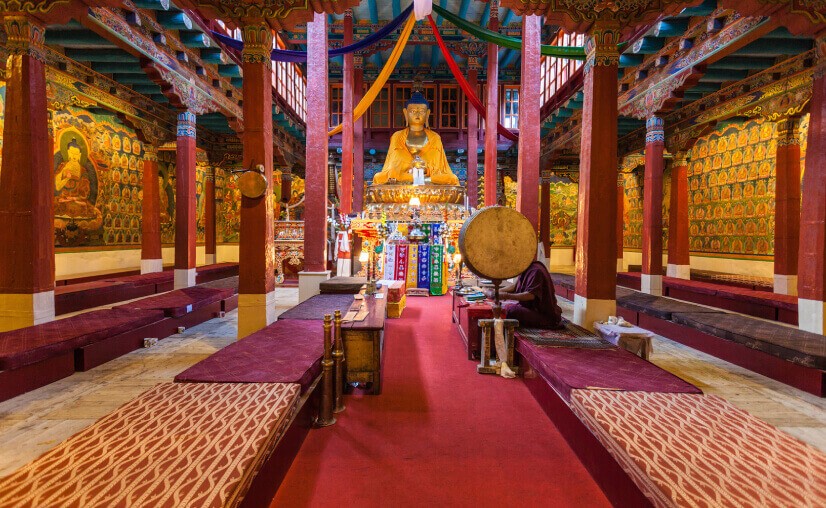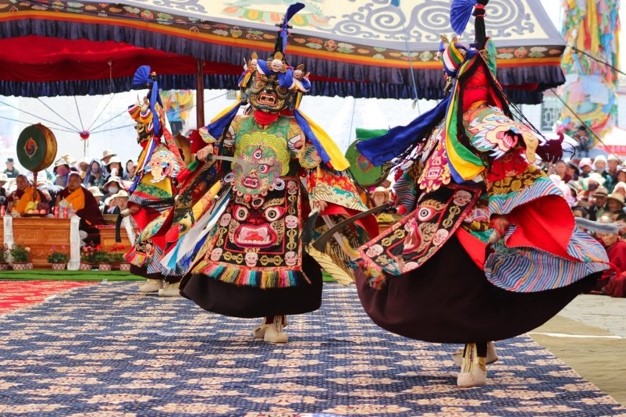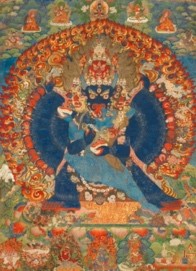Description

Disclaimer: Copyright infringement not intended.
Context
- Y20 delegates visited Hemis Monastery in Leh of Ladakh. The foreign delegates witnessed the famous Cham dance.
About Hemis Monastery
- The most popular monastery, Hemis Gompa is also dubbed the richest monastery in Ladakh.
- Hemis is a 17th century Buddhist shrine which was re-established in 1672.
- This famous monastery in Ladakh is of the Drukpa Lineage of Buddhism.
- The history of Hemis Monastery states that it is considered to have existed before the 11th century.
- The monastery of Hemis is connected with Naropa, the pupil of the yogi Tilopa, and teacher of the translator Marpa.
- It is believed that Naropa and yogi Tilopa met at Hemis and together from here they proceeded to the ancient kingdom of Magadha.
- Naropa was the founding father of the Kagyu-lineage of the Himalayan esoteric Buddhism. Therefore, Hemis Monastery is the main seat of the Kagyu lineage of Buddhism.

About Hemis Festival of Ladakh
- Marking the birth of Guru Padmasambhava, Hemis Festival is not only one of the most important Buddhist celebration in Ladakh but is also the most popular festival amongst tourists.
- It is a two-day event that is celebrated on the 10th day of the fifth month of Tibetan Calendar, which is the month of June/July in Gregorian Calendar.
Highlights of Hemis Festival
Cham Dance
- The Cham dance is a lively masked and costumed dance associated with some sects of Tibetan Buddhism.

- The dance also known as the God Dance is a colorful and impressive performance, and at the same time intimate and significant dance performed by Buddhist monks.
- Unlike common dance, Cham has a religious meaning, therefore, only monks and lamas can perform it.
- During the dance, monks impersonate deities and protectors.
- Monks accompany the dance with music played on traditional instruments. They play handheld drums, cymbals, large drums, blow horns, trumpets, and long trumpets. They chant along with the drum beats and recite mantras.
- Because Tibetan protectors appear in the wrathful form, some early travelers to Tibet even called it the “devil dance”.
- Another common character of a Cham Dance is a monk wearing a skull mask and skeleton-decorated costume. Tibetans are not intimidated by death, as they believe in reincarnation and perceive death as a necessary step for a new life and eventually, enlightenment.
- According to Tibetans, Padma Sambhava started the Cham Dance tradition. That’s why Cham dance often depicts scenes of Padmasambhava’s life.
- The center subject is the prayer to Buddha to subdue demons. The dance shows sentient beings suffering from bad obstacles, delusions, and troubles.
- Performers praise the merits of all Buddha and Bodhisattvas in ten directions with singing and dancing.
Unfurling of Thangkas (Buddhist paintings)
- A thangka is a Tibetan Buddhist painting on cotton, silk appliqué, usually depicting a Buddhist deity, scene, or mandala.
- Thangkas are traditionally kept unframed and rolled up when not on display, mounted on a textile backing somewhat in the style of Chinese scroll paintings, with a further silk cover on the front.
- Most thangkas were intended for personal meditation or instruction of monastic students.

|
PRACTICE QUESTION
Q) How many of the following statements with reference to Hemis festival is/are correct?
a. It marks the birth of Naropa, the founding father of the Kagyu-lineage of the Himalayan esoteric Buddhism.
b. A thangka is a Tibetan Buddhist painting on cotton usually depicting a Buddhist deity.
c. Cham dance has a religious meaning, therefore, only monks and lamas can perform it.
- Only 1
- Only 2
- Only 3
- None of the above
Correct Answer: 3
|

https://timesofindia.indiatimes.com/videos/news/ladakh-y20-delegates-visit-hemis-monastery-in-leh-witness-lively-cham-dance/videoshow/99814764.cms

















